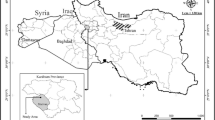Abstract
Anecdotal evidence suggests that iron ore dust derived from industrialshiploading activities in north-western Australia may be more injurious tomangroves than is naturally-derived dust, because of its more angularstructure and presumed ability to damage stomatal cells. Abaxial hairs onthe most common mangrove, Avicennia marina (Forfk). Vierh., havebeen thought to exacerbate this effect through trapping and retaining dust.This study examined this hypothesis. Leaves were collected from dustyindustrial areas and natural environments. Leaves in dusty environmentswere chosen on the basis of their thick coating of iron ore dust on both leafsurfaces. Approximately 3,000 stomata were examined in detail using lightmicroscopy. Hair density, stomatal aperture, cell condition and presence ofdust were also noted. Despite there often being a visible layer of dust onthe abaxial and adaxial surfaces of the leaf, evidence for dust of any kindwithin stomatal spaces was noted, in total, only three times. The lack ofvisible dust in stomata was attributed to three factors; the density andmorphology of the abaxial hairs, which prevent dust from enteringthe space between the hairs, and the improbability of dust circulating in thestagnant air within that space and moving against gravity past the guardcells. It was concluded that if iron ore dust affects mangroves, it must doso by some other mechanism, such as either increased temperature, shadingor a restriction of transpiration by the thickness of the dust on the abaxialsurface.
Similar content being viewed by others
References
Chittleborough, R.G. 1983. The Dampier Archipelago marine study: a progreess report. Bulletin 141. W. A. Department of Conservation and Environment. Western Australia.
Ernst, W.H.O. 1982. Monitoring of particulate pollutants. In: Steubing, L. and Jäger, H.-J. (eds.) Monitoring of Air Pollutants by Plants: Methods and Problems. Proceedings of the International Workshop, Osnabrück (F.R.G.), September 24–25, 1981. Dr W. Junk Publishers, The Hague.
Hirano, T., Kiyota, M. and Aiga, I. 1995. Physical effects of dust on leaf physiology of cucumber and kidney bean plants. Environmental Pollution 89: 255–261.
Jensen, W.A. 1962. Plant Microtechnique. McGraw-Hill Book Co. Inc. New York, USA.
Kulshreshtha, K., Farooqui, A., Srivastava, K., Singh, S.N., Ahmad, K.J. and Behl, H.M. 1994. Effect of diesel exhaust pollution on cuticular and epidermal features of Lantana camara L. and Syzygium cuminii L. (Skeels). Journal of Environmental Science & Health Part A-Environmental Science and Engineering 29: 301–308.
Meagher and LeProvost. 1976. Re-appraisal of the mangrove ecosystem, Port Hedland. Mt Newman Mining Co Pty Ltd. Western Australia.
Paling, E.I., McComb, A.J. and Pate, J.S. 1989. Nitrogen fixation (acetylene reduction) in nonheterocystous cyanobacterial mats from the Dampier Archipelago, Western Australia. Australian Journal of Marine and Freshwater Research 40: 147–153.
Ricks, G.R. and Williams, R.J.H. 1974. Effects of atmospheric pollution on deciduous woodland Part 2: Effects of particulate matter upon stomatal diffusion resistance in leaves of Quercus petraes (Mattuschka) Leibl. Environmental Pollution 6: 87–109.
Sass, J.E. 1958. Botanical Microtechnique 3rd. Edition. Iowa State University Press: Ames, Iowa USA.
Semeniuk Research Group, V.C. 1994. Study of the impacts of Pilbara coastal developments on arid zone mangroves-Stage 3: Assessment of impacts of the iron ore industry. Perth, V & C Semeniuk Research Group.
Semenuik, V. 1987. Threats to, and exploitation and destruction of mangrove systems inWestern Australia. In: Field, C.D. and Dartnell, A.J. (eds.), Mangrove Ecosystems of Asia and the Pacific-Status, Exploitation and Management. pp. 228–240. Proceedings on Research for Development. Seminar, AIMS, May 1985.
Sharifi, M.R., Gibson, A.C. and Rundel, P.W. 1997. Surface dust impacts on gas exchange in Mojave Desert shrubs. Journal of Applied Ecology 34: 837–846.
Author information
Authors and Affiliations
Rights and permissions
About this article
Cite this article
Paling, E., Humphries, G., McCardle, I. et al. The effects of iron ore dust on mangroves in Western Australia: Lack of evidence for stomatal damage. Wetlands Ecology and Management 9, 363–370 (2001). https://doi.org/10.1023/A:1012008705347
Issue Date:
DOI: https://doi.org/10.1023/A:1012008705347




